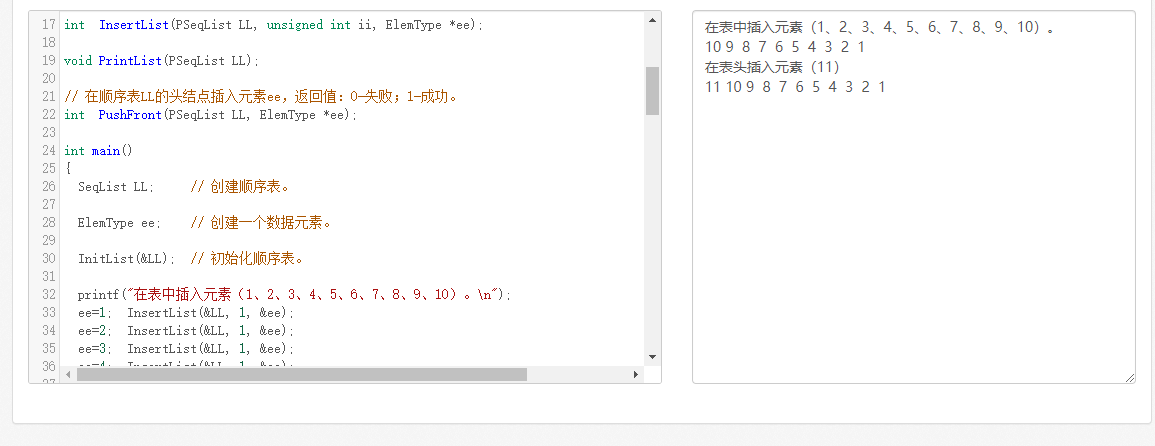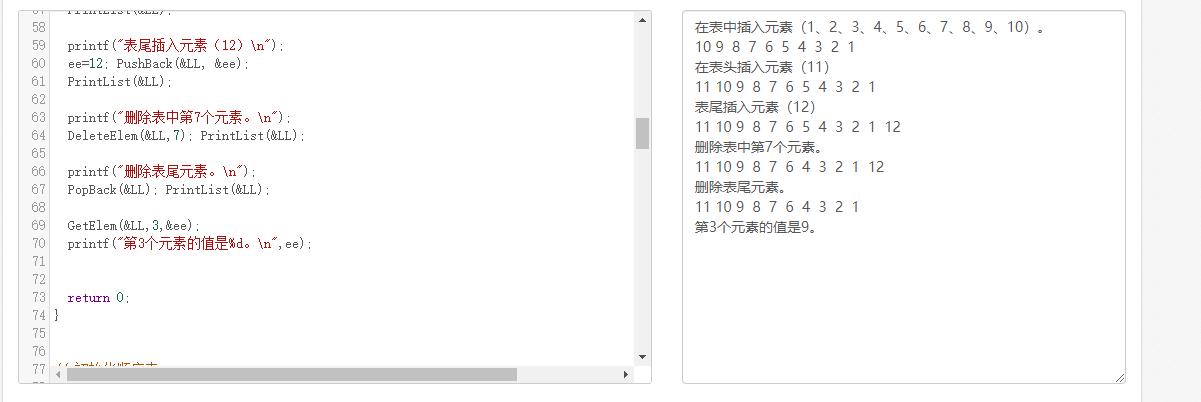一、步骤
1、定义一个结构体
2、创建一个顺序表
3、创建一个数据元素
4、初始化顺序表
5、在表中插入元素
6、 打印顺序表中全部的元素。
7、在表头插入元素
8、表尾插入元素
9、删除第n个元素
10、删除末尾元素
11、获取第n个元素的值
12、获取元素值所在的位置
二、代码
1、定义一个结构体
#include <stdio.h>
#include <string.h>
#define MAXSIZE 100 // 顺序表的最大长度
typedef int ElemType; // 自定义顺序表的数据元素为整数。
typedef struct
{
ElemType data[MAXSIZE]; // 用数组存储顺序表中的元素
unsigned int length; // 顺序表中元素的个数
}SeqList,*PSeqList;
int main()
{
return 0;
}
2、创建一个顺序表
int main()
{
SeqList LL; // 创建顺序表
return 0;
}
3、创建一个数据元素
int main()
{
SeqList LL; // 创建顺序表
ElemType ee; // 创建一个数据元素。
return 0;
}
4、初始化顺序表
void InitList(PSeqList LL)
void ClearList(PSeqList LL)
int main()
{
SeqList LL; // 创建顺序表
ElemType ee; // 创建一个数据元素。
InitList(&LL); // 初始化顺序表。
return 0;
}
******************************初始化顺序表*******************************************************
// 初始化顺序表
void InitList(PSeqList LL)
{
ClearList(LL); // 清空顺序表。
}
******************************初始化顺序表*******************************************************
******************************清空顺序表。*******************************************************
// 清空顺序表。
void ClearList(PSeqList LL)
{
if (LL == NULL) return; // 检查空指针。
LL->length=0; // 表长置为0。
memset(LL->data,0,sizeof(ElemType)*MAXSIZE); // 数组元素清0。
}
******************************清空顺序表*******************************************************
5、在表中插入元素
int InsertList(PSeqList LL, unsigned int ii, ElemType *ee);
int main()
{
SeqList LL; // 创建顺序表
ElemType ee; // 创建一个数据元素。
InitList(&LL); // 初始化顺序表。
printf("在表中插入元素(1、2、3、4、5、6、7、8、9、10)。\n");
ee=1; InsertList(&LL, 1, &ee);
ee=2; InsertList(&LL, 1, &ee);
ee=3; InsertList(&LL, 1, &ee);
ee=4; InsertList(&LL, 1, &ee);
ee=5; InsertList(&LL, 1, &ee);
ee=6; InsertList(&LL, 1, &ee);
ee=7; InsertList(&LL, 1, &ee);
ee=8; InsertList(&LL, 1, &ee);
ee=9; InsertList(&LL, 1, &ee);
ee=10; InsertList(&LL, 1, &ee);
return 0;
}
// 在顺序表LL的第ii个位置插入元素ee,返回值:0-失败;1-成功。
int InsertList(PSeqList LL, unsigned int ii, ElemType *ee)
{
if ( (LL == NULL) || (ee == NULL) ) return 0; // 检查空指针。
if (LL->length >= MAXSIZE)
{
printf("顺序表已满,不能插入。\n"); return 0;
}
// 判断插入位置是否合法
if ( (ii < 1) || (ii > LL->length+1) )
{
printf("插入位置(%d)不合法,应该在(%d-%d)之间。\n",ii,1,LL->length+1); return 0;
}
// 注意,元素后移只能用循环,不能用以下注释掉的方法,当元素是结构体时,以下方法不稳定。
// if ( ii < LL->length+1)
// memcpy(LL->data+ii,LL->data+ii-1,(LL->length-ii+1)*sizeof(ElemType));
// 把ii和ii之后的元素后移。
int kk;
for (kk=LL->length;kk>=ii;kk--)
{
// memcpy(LL->data+kk,LL->data+kk-1,sizeof(ElemType)); // 采用memcpy是为了支持ee为结构体的情况。
memcpy(&LL->data[kk],&LL->data[kk-1],sizeof(ElemType)); // 用数组的形式也可以。
}
//memcpy(LL->data+ii-1,ee,sizeof(ElemType)); // 采用memcpy是为了支持ee为结构体的情况。
memcpy(&LL->data[ii-1],ee,sizeof(ElemType)); // 用数组的形式也可以。
LL->length++; // 表的长度加1。
return 1;
}
6、 打印顺序表中全部的元素。
void PrintList(PSeqList LL);
int main()
{
SeqList LL; // 创建顺序表
ElemType ee; // 创建一个数据元素。
InitList(&LL); // 初始化顺序表。
printf("在表中插入元素(1、2、3、4、5、6、7、8、9、10)。\n");
ee=1; InsertList(&LL, 1, &ee);
ee=2; InsertList(&LL, 1, &ee);
ee=3; InsertList(&LL, 1, &ee);
ee=4; InsertList(&LL, 1, &ee);
ee=5; InsertList(&LL, 1, &ee);
ee=6; InsertList(&LL, 1, &ee);
ee=7; InsertList(&LL, 1, &ee);
ee=8; InsertList(&LL, 1, &ee);
ee=9; InsertList(&LL, 1, &ee);
ee=10; InsertList(&LL, 1, &ee);
PrintList(&LL);
return 0;
}
// 打印顺序表中全部的元素。
void PrintList(PSeqList LL)
{
if (LL == NULL) return; // 检查空指针。
if (LL->length == 0) { printf("表为空。\n"); return; }
int kk;
for (kk = 0; kk < LL->length; kk++)
{
// printf("%-3d", *(LL->data+kk)); // 如果元素ee为结构体,这行代码要修改。
printf("%-3d", LL->data[kk]); // 用数组的形式也可以。
}
printf("\n");
}

7、在表头插入元素
// 在顺序表LL的头结点插入元素ee,返回值:0-失败;1-成功。
int PushFront(PSeqList LL, ElemType *ee);
int main()
{
SeqList LL; // 创建顺序表。
ElemType ee; // 创建一个数据元素。
InitList(&LL); // 初始化顺序表。
printf("在表中插入元素(1、2、3、4、5、6、7、8、9、10)。\n");
ee=1; InsertList(&LL, 1, &ee);
ee=2; InsertList(&LL, 1, &ee);
ee=3; InsertList(&LL, 1, &ee);
ee=4; InsertList(&LL, 1, &ee);
ee=5; InsertList(&LL, 1, &ee);
ee=6; InsertList(&LL, 1, &ee);
ee=7; InsertList(&LL, 1, &ee);
ee=8; InsertList(&LL, 1, &ee);
ee=9; InsertList(&LL, 1, &ee);
ee=10; InsertList(&LL, 1, &ee);
PrintList(&LL);
printf("在表头插入元素(11)\n");
ee=11; PushFront(&LL, &ee);
PrintList(&LL);
return 0;
}
// 在顺序表LL的头结点插入元素ee,返回值:0-失败;1-成功。
int PushFront(PSeqList LL, ElemType *ee)
{
return InsertList(LL,1,ee);
}

8、表尾插入元素(12)
// 在顺序表LL的尾结点插入元素ee,返回值:0-失败;1-成功。
int PushBack(PSeqList LL, ElemType *ee);
int main()
{
SeqList LL; // 创建顺序表。
ElemType ee; // 创建一个数据元素。
InitList(&LL); // 初始化顺序表。
printf("在表中插入元素(1、2、3、4、5、6、7、8、9、10)。\n");
ee=1; InsertList(&LL, 1, &ee);
ee=2; InsertList(&LL, 1, &ee);
ee=3; InsertList(&LL, 1, &ee);
ee=4; InsertList(&LL, 1, &ee);
ee=5; InsertList(&LL, 1, &ee);
ee=6; InsertList(&LL, 1, &ee);
ee=7; InsertList(&LL, 1, &ee);
ee=8; InsertList(&LL, 1, &ee);
ee=9; InsertList(&LL, 1, &ee);
ee=10; InsertList(&LL, 1, &ee);
PrintList(&LL);
printf("在表头插入元素(11)\n");
ee=11; PushFront(&LL, &ee);
PrintList(&LL);
printf("表尾插入元素(12)\n");
ee=12; PushBack(&LL, &ee);
PrintList(&LL);
return 0;
}
// 在顺序表LL的尾结点插入元素ee,返回值:0-失败;1-成功。
int PushBack(PSeqList LL, ElemType *ee)
{
return InsertList(LL,LL->length+1,ee);
}

9、删除第7个元素
int DeleteElem(PSeqList LL, unsigned int ii);
int main()
{
SeqList LL; // 创建顺序表。
ElemType ee; // 创建一个数据元素。
InitList(&LL); // 初始化顺序表。
printf("在表中插入元素(1、2、3、4、5、6、7、8、9、10)。\n");
ee=1; InsertList(&LL, 1, &ee);
ee=2; InsertList(&LL, 1, &ee);
ee=3; InsertList(&LL, 1, &ee);
ee=4; InsertList(&LL, 1, &ee);
ee=5; InsertList(&LL, 1, &ee);
ee=6; InsertList(&LL, 1, &ee);
ee=7; InsertList(&LL, 1, &ee);
ee=8; InsertList(&LL, 1, &ee);
ee=9; InsertList(&LL, 1, &ee);
ee=10; InsertList(&LL, 1, &ee);
PrintList(&LL);
printf("在表头插入元素(11)\n");
ee=11; PushFront(&LL, &ee);
PrintList(&LL);
printf("表尾插入元素(12)\n");
ee=12; PushBack(&LL, &ee);
PrintList(&LL);
printf("删除表中第7个元素。\n");
DeleteElem(&LL,7);
PrintList(&LL);
return 0;
}
// 删除顺序表LL中的第ii个元素,返回值:0-位置ii不合法;1-成功。
int DeleteElem(PSeqList LL, unsigned int ii)
{
if (LL == NULL) return 0; // 检查空指针。
// 判断删除位置ii是否合法
if ( (ii < 1) || (ii > LL->length) )
{
printf("删除位置(%d)不合法,应该在(%d-%d)之间\n",ii,1,LL->length); return 0;
}
// 把ii之后的元素前移。
int k;
for (k=ii;k<=LL->length;k++)
{
// memcpy(LL->data+k-1,LL->data+k,sizeof(ElemType)); // 采用memcpy是为了支持ee为结构体的情况。
memcpy(&LL->data[k-1],&LL->data[k],sizeof(ElemType)); // 用数组的形式也可以。
}
LL->length--; // 表的长度减1。
return 1;
}
10、删除末尾元素
// 删除顺序表LL中尾元素,返回值:0-位置ii不合法;1-成功。
int PopBack(PSeqList LL);
int main()
{
SeqList LL; // 创建顺序表。
ElemType ee; // 创建一个数据元素。
InitList(&LL); // 初始化顺序表。
printf("在表中插入元素(1、2、3、4、5、6、7、8、9、10)。\n");
ee=1; InsertList(&LL, 1, &ee);
ee=2; InsertList(&LL, 1, &ee);
ee=3; InsertList(&LL, 1, &ee);
ee=4; InsertList(&LL, 1, &ee);
ee=5; InsertList(&LL, 1, &ee);
ee=6; InsertList(&LL, 1, &ee);
ee=7; InsertList(&LL, 1, &ee);
ee=8; InsertList(&LL, 1, &ee);
ee=9; InsertList(&LL, 1, &ee);
ee=10; InsertList(&LL, 1, &ee);
PrintList(&LL);
printf("在表头插入元素(11)\n");
ee=11; PushFront(&LL, &ee);
PrintList(&LL);
printf("表尾插入元素(12)\n");
ee=12; PushBack(&LL, &ee);
PrintList(&LL);
printf("删除表中第7个元素。\n");
DeleteElem(&LL,7);
PrintList(&LL);
printf("删除表尾元素。\n");
PopBack(&LL); PrintList(&LL);
return 0;
}
// 删除顺序表LL中尾元素,返回值:0-位置ii不合法;1-成功。
int PopBack(PSeqList LL)
{
return DeleteElem(LL, LL->length);
}

11、获取第n个元素的值
// 获取顺序表中第ii个元素的值,存放在ee中,返回值:0-失败;1-成功。
int GetElem(PSeqList LL, unsigned int ii, ElemType* ee);
int main()
{
SeqList LL; // 创建顺序表。
ElemType ee; // 创建一个数据元素。
InitList(&LL); // 初始化顺序表。
printf("在表中插入元素(1、2、3、4、5、6、7、8、9、10)。\n");
ee=1; InsertList(&LL, 1, &ee);
ee=2; InsertList(&LL, 1, &ee);
ee=3; InsertList(&LL, 1, &ee);
ee=4; InsertList(&LL, 1, &ee);
ee=5; InsertList(&LL, 1, &ee);
ee=6; InsertList(&LL, 1, &ee);
ee=7; InsertList(&LL, 1, &ee);
ee=8; InsertList(&LL, 1, &ee);
ee=9; InsertList(&LL, 1, &ee);
ee=10; InsertList(&LL, 1, &ee);
PrintList(&LL);
printf("在表头插入元素(11)\n");
ee=11; PushFront(&LL, &ee);
PrintList(&LL);
printf("表尾插入元素(12)\n");
ee=12; PushBack(&LL, &ee);
PrintList(&LL);
printf("删除表中第7个元素。\n");
DeleteElem(&LL,7);
PrintList(&LL);
printf("删除表尾元素。\n");
PopBack(&LL); PrintList(&LL);
GetElem(&LL,3,&ee);
printf("第3个元素的值是%d。\n",ee);
return 0;
}
// 获取顺序表中第ii个元素的值,存放在ee中,返回值:0-失败;1-成功。
int GetElem(PSeqList LL, unsigned int ii, ElemType* ee)
{
if ( (LL == NULL) || (ee == NULL) ) return 0; // 检查空指针。
// 判断位置ii是否合法
if ( (ii < 1) || (ii > LL->length) ) return 0;
//memcpy(ee,LL->data+ii-1,sizeof(ElemType)); // 采用memcpy是为了支持ee为结构体的情况。
memcpy(ee,&LL->data[ii-1],sizeof(ElemType)); // 用数组的形式也可以。
return ;
}

12、获取元素值所在的位置
// 查找ee在顺序表LL中的位置,返回值:0-元素ee在表LL中不存在,>0元素ee在表LL中的位置。
int LocateElem(PSeqList LL, ElemType *ee);
int main()
{
SeqList LL; // 创建顺序表。
ElemType ee; // 创建一个数据元素。
InitList(&LL); // 初始化顺序表。
printf("在表中插入元素(1、2、3、4、5、6、7、8、9、10)。\n");
ee=1; InsertList(&LL, 1, &ee);
ee=2; InsertList(&LL, 1, &ee);
ee=3; InsertList(&LL, 1, &ee);
ee=4; InsertList(&LL, 1, &ee);
ee=5; InsertList(&LL, 1, &ee);
ee=6; InsertList(&LL, 1, &ee);
ee=7; InsertList(&LL, 1, &ee);
ee=8; InsertList(&LL, 1, &ee);
ee=9; InsertList(&LL, 1, &ee);
ee=10; InsertList(&LL, 1, &ee);
PrintList(&LL);
printf("在表头插入元素(11)\n");
ee=11; PushFront(&LL, &ee);
PrintList(&LL);
printf("表尾插入元素(12)\n");
ee=12; PushBack(&LL, &ee);
PrintList(&LL);
printf("删除表中第7个元素。\n");
DeleteElem(&LL,7);
PrintList(&LL);
printf("删除表尾元素。\n");
PopBack(&LL); PrintList(&LL);
GetElem(&LL,3,&ee);
printf("第3个元素的值是%d。\n",ee);
ee=8;
printf("元素值为8的位置是=%d\n",LocateElem(&LL,&ee));
return 0;
}
// 查找ee在顺序表LL中的位置,返回值:0-元素ee在表LL中不存在,>0元素ee在表LL中的位置。
int LocateElem(PSeqList LL, ElemType *ee)
{
if ( (LL == NULL) || (ee == NULL) ) return 0; // 检查空指针。
int kk;
for (kk = 0; kk < LL->length; kk++)
{
// 如果元素ee为结构体,这行代码要修改。
// if (*(LL->data+kk) == *ee) return kk+1; // 在表中对应序号应为kk+1。
if (LL->data[kk] == *ee) return kk+1; // 用数组的形式也可以。
}
return 0;
}

三、完整代码
/*
* 程序名:seqlist1.c,此程序演示顺序表的静态实现,数据元素是整数。
* 作者:C语言技术网(www.freecplus.net) 日期:20201230
*/
#include <stdio.h>
#include <string.h>
#define MAXSIZE 100 // 顺序表的最大长度
typedef int ElemType; // 自定义顺序表的数据元素为整数。
typedef struct
{
ElemType data[MAXSIZE]; // 用数组存储顺序表中的元素
unsigned int length; // 顺序表中元素的个数
}SeqList,*PSeqList;
// 顺序表LL的初始化操作。
void InitList(PSeqList LL);
// 销毁顺序表LL。
void DestroyList(PSeqList LL);
// 在顺序表LL的第ii个位置插入元素ee,返回值:0-失败;1-成功。
int InsertList(PSeqList LL, unsigned int ii, ElemType *ee);
// 在顺序表LL的头结点插入元素ee,返回值:0-失败;1-成功。
int PushFront(PSeqList LL, ElemType *ee);
// 在顺序表LL的尾结点插入元素ee,返回值:0-失败;1-成功。
int PushBack(PSeqList LL, ElemType *ee);
// 求顺序表的长度,返回值:>=0-表LL元素的个数。
int LengthList(PSeqList LL);
// 获取顺序表中第ii个元素的值,存放在ee中,返回值:0-失败;1-成功。
int GetElem(PSeqList LL, unsigned int ii, ElemType* ee);
// 清空顺序表。
void ClearList(PSeqList LL);
// 判断顺序表是否为空,返回值:1-空,0-非空或失败。
int IsEmpty(PSeqList LL);
// 打印顺序表中全部的元素。
void PrintList(PSeqList LL);
// 查找ee在顺序表LL中的位置,返回值:0-元素ee在表LL中不存在,>0元素ee在表LL中的位置。
int LocateElem(PSeqList LL, ElemType *ee);
// 删除顺序表LL中的第ii个元素,返回值:0-位置ii不合法;1-成功。
int DeleteElem(PSeqList LL, unsigned int ii);
// 删除顺序表LL中头元素,返回值:0-位置ii不合法;1-成功。
int PopFront(PSeqList LL);
// 删除顺序表LL中尾元素,返回值:0-位置ii不合法;1-成功。
int PopBack(PSeqList LL);
// 采用归并的方法,将两个升序的顺序表La和Lb,合并成一个升序的顺序表Lc。
int MergeList(PSeqList La,PSeqList Lb,PSeqList Lc);
int main()
{
SeqList LL; // 创建顺序表。
ElemType ee; // 创建一个数据元素。
InitList(&LL); // 初始化顺序表。
printf("在表中插入元素(1、2、3、4、5、6、7、8、9、10)。\n");
ee=1; InsertList(&LL, 1, &ee);
ee=2; InsertList(&LL, 1, &ee);
ee=3; InsertList(&LL, 1, &ee);
ee=4; InsertList(&LL, 1, &ee);
ee=5; InsertList(&LL, 1, &ee);
ee=6; InsertList(&LL, 1, &ee);
ee=7; InsertList(&LL, 1, &ee);
ee=8; InsertList(&LL, 1, &ee);
ee=9; InsertList(&LL, 1, &ee);
ee=10; InsertList(&LL, 1, &ee);
PrintList(&LL);
printf("在表头插入元素(11),表尾插入元素(12)。\n");
ee=11; PushFront(&LL, &ee);
ee=12; PushBack(&LL, &ee);
PrintList(&LL);
printf("在第5个位置插入元素(13)。\n");
ee=13; InsertList(&LL, 5, &ee);
PrintList(&LL);
printf("删除表中第7个元素。\n");
DeleteElem(&LL,7); PrintList(&LL);
printf("删除表头元素。\n");
PopFront(&LL); PrintList(&LL);
printf("删除表尾元素。\n");
PopBack(&LL); PrintList(&LL);
GetElem(&LL,3,&ee);
printf("第3个元素的值是%d。\n",ee);
ee=8;
printf("元素值为8的位置是=%d\n",LocateElem(&LL,&ee));
/*
// 以下代码显示两个顺序表的合并,把两个有序的La和Lb合并成有序的Lc。
SeqList La,Lb,Lc;
InitList(&La);
InitList(&Lb);
InitList(&Lc);
ee=1; PushBack(&Lb, &ee);
ee=2; PushBack(&La, &ee);
ee=3; PushBack(&Lb, &ee);
ee=4; PushBack(&Lb, &ee);
ee=5; PushBack(&La, &ee);
ee=6; PushBack(&Lb, &ee);
ee=7; PushBack(&Lb, &ee);
ee=8; PushBack(&Lb, &ee);
ee=9; PushBack(&La, &ee);
ee=10; PushBack(&La, &ee);
PrintList(&La);
PrintList(&Lb);
MergeList(&La,&Lb,&Lc);
PrintList(&Lc);
*/
return 0;
}
// 初始化顺序表
void InitList(PSeqList LL)
{
ClearList(LL); // 清空顺序表。
}
// 清空顺序表。
void ClearList(PSeqList LL)
{
if (LL == NULL) return; // 检查空指针。
LL->length=0; // 表长置为0。
memset(LL->data,0,sizeof(ElemType)*MAXSIZE); // 数组元素清0。
}
// 求顺序表的长度,返回值:>=0-表LL元素的个数。
int LengthList(PSeqList LL)
{
if (LL == NULL) return 0; // 检查空指针。
return LL->length;
}
// 获取顺序表中第ii个元素的值,存放在ee中,返回值:0-失败;1-成功。
int GetElem(PSeqList LL, unsigned int ii, ElemType* ee)
{
if ( (LL == NULL) || (ee == NULL) ) return 0; // 检查空指针。
// 判断位置ii是否合法
if ( (ii < 1) || (ii > LL->length) ) return 0;
//memcpy(ee,LL->data+ii-1,sizeof(ElemType)); // 采用memcpy是为了支持ee为结构体的情况。
memcpy(ee,&LL->data[ii-1],sizeof(ElemType)); // 用数组的形式也可以。
return ;
}
// 在顺序表LL的第ii个位置插入元素ee,返回值:0-失败;1-成功。
int InsertList(PSeqList LL, unsigned int ii, ElemType *ee)
{
if ( (LL == NULL) || (ee == NULL) ) return 0; // 检查空指针。
if (LL->length >= MAXSIZE)
{
printf("顺序表已满,不能插入。\n"); return 0;
}
// 判断插入位置是否合法
if ( (ii < 1) || (ii > LL->length+1) )
{
printf("插入位置(%d)不合法,应该在(%d-%d)之间。\n",ii,1,LL->length+1); return 0;
}
// 注意,元素后移只能用循环,不能用以下注释掉的方法,当元素是结构体时,以下方法不稳定。
// if ( ii < LL->length+1)
// memcpy(LL->data+ii,LL->data+ii-1,(LL->length-ii+1)*sizeof(ElemType));
// 把ii和ii之后的元素后移。
int kk;
for (kk=LL->length;kk>=ii;kk--)
{
// memcpy(LL->data+kk,LL->data+kk-1,sizeof(ElemType)); // 采用memcpy是为了支持ee为结构体的情况。
memcpy(&LL->data[kk],&LL->data[kk-1],sizeof(ElemType)); // 用数组的形式也可以。
}
//memcpy(LL->data+ii-1,ee,sizeof(ElemType)); // 采用memcpy是为了支持ee为结构体的情况。
memcpy(&LL->data[ii-1],ee,sizeof(ElemType)); // 用数组的形式也可以。
LL->length++; // 表的长度加1。
return 1;
}
// 在顺序表LL的头结点插入元素ee,返回值:0-失败;1-成功。
int PushFront(PSeqList LL, ElemType *ee)
{
return InsertList(LL,1,ee);
}
// 在顺序表LL的尾结点插入元素ee,返回值:0-失败;1-成功。
int PushBack(PSeqList LL, ElemType *ee)
{
return InsertList(LL,LL->length+1,ee);
}
// 删除顺序表LL中的第ii个元素,返回值:0-位置ii不合法;1-成功。
int DeleteElem(PSeqList LL, unsigned int ii)
{
if (LL == NULL) return 0; // 检查空指针。
// 判断删除位置ii是否合法
if ( (ii < 1) || (ii > LL->length) )
{
printf("删除位置(%d)不合法,应该在(%d-%d)之间\n",ii,1,LL->length); return 0;
}
// 把ii之后的元素前移。
int k;
for (k=ii;k<=LL->length;k++)
{
// memcpy(LL->data+k-1,LL->data+k,sizeof(ElemType)); // 采用memcpy是为了支持ee为结构体的情况。
memcpy(&LL->data[k-1],&LL->data[k],sizeof(ElemType)); // 用数组的形式也可以。
}
LL->length--; // 表的长度减1。
return 1;
}
// 查找ee在顺序表LL中的位置,返回值:0-元素ee在表LL中不存在,>0元素ee在表LL中的位置。
int LocateElem(PSeqList LL, ElemType *ee)
{
if ( (LL == NULL) || (ee == NULL) ) return 0; // 检查空指针。
int kk;
for (kk = 0; kk < LL->length; kk++)
{
// 如果元素ee为结构体,这行代码要修改。
// if (*(LL->data+kk) == *ee) return kk+1; // 在表中对应序号应为kk+1。
if (LL->data[kk] == *ee) return kk+1; // 用数组的形式也可以。
}
return 0;
}
// 删除顺序表LL中头元素,返回值:0-位置ii不合法;1-成功。
int PopFront(PSeqList LL)
{
return DeleteElem(LL, 1);
}
// 删除顺序表LL中尾元素,返回值:0-位置ii不合法;1-成功。
int PopBack(PSeqList LL)
{
return DeleteElem(LL, LL->length);
}
// 判断顺序表是否为空,返回值:1-空,0-非空或失败。
int IsEmpty(PSeqList LL)
{
if (LL == NULL) return 0; // 检查空指针。
if (LL->length == 0) return 1;
return 0;
}
// 打印顺序表中全部的元素。
void PrintList(PSeqList LL)
{
if (LL == NULL) return; // 检查空指针。
if (LL->length == 0) { printf("表为空。\n"); return; }
int kk;
for (kk = 0; kk < LL->length; kk++)
{
// printf("%-3d", *(LL->data+kk)); // 如果元素ee为结构体,这行代码要修改。
printf("%-3d", LL->data[kk]); // 用数组的形式也可以。
}
printf("\n");
}
// 采用归并的方法,将两个升序的顺序表La和Lb,合并成一个升序的顺序表Lc。
int MergeList(PSeqList La,PSeqList Lb,PSeqList Lc)
{
if ( (La == NULL) || (Lb == NULL) || (Lc == NULL) ) // 检查空指针。
if ( MAXSIZE < La->length + Lb->length ) { printf("表Lc的长度不够。\n"); return 0; }
int istartla=0; // 表La第一个元素的位置。
int istartlb=0; // 表Lb第一个元素的位置。
int istartlc=0; // 表Lc第一个元素的位置。
// 把La和Lb合并到Lc中。
while (istartla < La->length && istartlb < Lb->length)
Lc->data[istartlc++]=La->data[istartla]<Lb->data[istartlb] ? La->data[istartla++] : Lb->data[istartlb++];
// 把La其它的元素追加到Lc中。
while (istartla < La->length) Lc->data[istartlc++]=La->data[istartla++];
// 把Lb其它的元素追加到Lc中。
while (istartlb < Lb->length) Lc->data[istartlc++]=Lb->data[istartlb++];
Lc->length=La->length + Lb->length;
return 1;
}
// 销毁顺序表LL。
void DestroyList(PSeqList LL)
{
// 静态顺序表无需释放内存,不需要销毁操作。
return;
}







